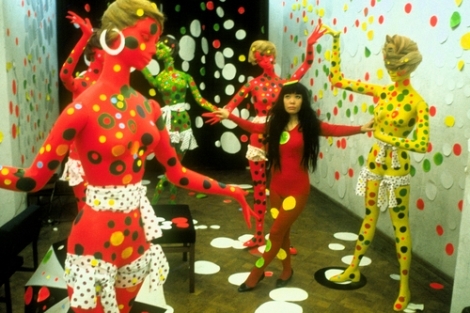
- This event has passed.

Film Still from Kusama—Infinity: The Life and Art of Yayoi Kusama. Photo: Copyright Harrie Verstappen
Film & Talk: Kusama—Infinity, The Life and Art of Yayoi Kusama
March 24, 2019, 2 pm - 4 pm
Talk with Terrie Sultan and John Torreano
$15 | $5 for Members, Children, and Students
Part of The Artist’s Lens, a new documentary series on artists, co-presented with Hamptons Doc Fest. Followed by a talk with Parrish Director Terrie Sultan and artist John Torreano.
Now the top-selling female artist in the world, Yayoi Kusama overcame impossible odds to bring her radical artistic vision to the world stage. For decades, her work pushed boundaries that often alienated her from both her peers and those in power in the art world. Kusama was an underdog with everything stacked against her: the trauma of growing up in Japan during World War II, life in a dysfunctional family that discouraged her creative ambitions, sexism and racism in the art establishment, mental illness in a culture where that was particularly shameful and even continuing to pursue and be devoted to her art full time on the cusp of her 90s. In spite of it all, Kusama has endured and has created a legacy of artwork that spans the disciplines of painting, sculpture, installation art, performance art, poetry and literary fiction.
Born in 1929, Kusama grew up near her family’s plant nursery in Matsumoto. At 19, she went to Kyoto to study the traditional Japanese style of painting known as Nihonga. During this time, she began experimenting with abstraction, but it was not until she arrived in the United States, in 1957, that her career took off. Living in New York from 1958 to 1973, Kusama moved in avant-garde circles and counted Donald Judd and Eva Hesse among her close friends and is often considered an influence on Andy Warhol and a precursor to Pop art. While honing her signature dot and net motifs, she developed soft sculpture, created installation-based works, and staged Happenings (performance-based events). She created the “Infinity Nets,” hallucinatory paintings of loops and dots and physical representations of the idea of infinity. She first used mirrors as a multi-reflective device in Infinity Mirror Room—Phalli’s Field, 1965, transforming the intense repetition that marked some of her earlier works into an immersive experience. Narcissus Garden, an installation of hundreds of mirrored balls, earned Kusama notoriety at the 1966 Venice Biennale, where she attempted to sell the individual spheres to passersby.
Since her return to Japan in 1973, Kusama’s work has continued to appeal to the imagination and the senses of people around the globe as they experience her dizzying walk-in installations, public sculptures, and the “Dots Obsessions” paintings in record numbers. Meanwhile, Kusama continues to create new work every day.
Film & Talk: Kusama—Infinity, The Life and Art of Yayoi Kusama
March 24, 2019, 2 pm - 4 pm
Talk with Terrie Sultan and John Torreano
$15 | $5 for Members, Children, and Students
Part of The Artist’s Lens, a new documentary series on artists, co-presented with Hamptons Doc Fest. Followed by a talk with Parrish Director Terrie Sultan and artist John Torreano.
Now the top-selling female artist in the world, Yayoi Kusama overcame impossible odds to bring her radical artistic vision to the world stage. For decades, her work pushed boundaries that often alienated her from both her peers and those in power in the art world. Kusama was an underdog with everything stacked against her: the trauma of growing up in Japan during World War II, life in a dysfunctional family that discouraged her creative ambitions, sexism and racism in the art establishment, mental illness in a culture where that was particularly shameful and even continuing to pursue and be devoted to her art full time on the cusp of her 90s. In spite of it all, Kusama has endured and has created a legacy of artwork that spans the disciplines of painting, sculpture, installation art, performance art, poetry and literary fiction.
Born in 1929, Kusama grew up near her family’s plant nursery in Matsumoto. At 19, she went to Kyoto to study the traditional Japanese style of painting known as Nihonga. During this time, she began experimenting with abstraction, but it was not until she arrived in the United States, in 1957, that her career took off. Living in New York from 1958 to 1973, Kusama moved in avant-garde circles and counted Donald Judd and Eva Hesse among her close friends and is often considered an influence on Andy Warhol and a precursor to Pop art. While honing her signature dot and net motifs, she developed soft sculpture, created installation-based works, and staged Happenings (performance-based events). She created the “Infinity Nets,” hallucinatory paintings of loops and dots and physical representations of the idea of infinity. She first used mirrors as a multi-reflective device in Infinity Mirror Room—Phalli’s Field, 1965, transforming the intense repetition that marked some of her earlier works into an immersive experience. Narcissus Garden, an installation of hundreds of mirrored balls, earned Kusama notoriety at the 1966 Venice Biennale, where she attempted to sell the individual spheres to passersby.
Since her return to Japan in 1973, Kusama’s work has continued to appeal to the imagination and the senses of people around the globe as they experience her dizzying walk-in installations, public sculptures, and the “Dots Obsessions” paintings in record numbers. Meanwhile, Kusama continues to create new work every day.

